Sensitive Data Protection può oscurare il testo sensibile di un'immagine. Utilizzando i rivelatori di tipo di informazione e Cloud Vision, Sensitive Data Protection ispeziona un'immagine per rilevare il testo, rileva i dati sensibili all'interno del testo e restituisce un'immagine con eventuali dati sensibili corrispondenti oscurati da un rettangolo opaco.
Ad esempio, prendi in considerazione le seguenti immagini "prima" e "dopo". L'immagine originale è un esempio di un tipico file immagine generato dalla scansione di un documento cartaceo. In questo esempio, la funzionalità Protezione dei dati sensibili è stata configurata per oscurare codici fiscali, indirizzi email e numeri di telefono statunitensi utilizzando rettangoli di diversi colori, a seconda dei contenuti.
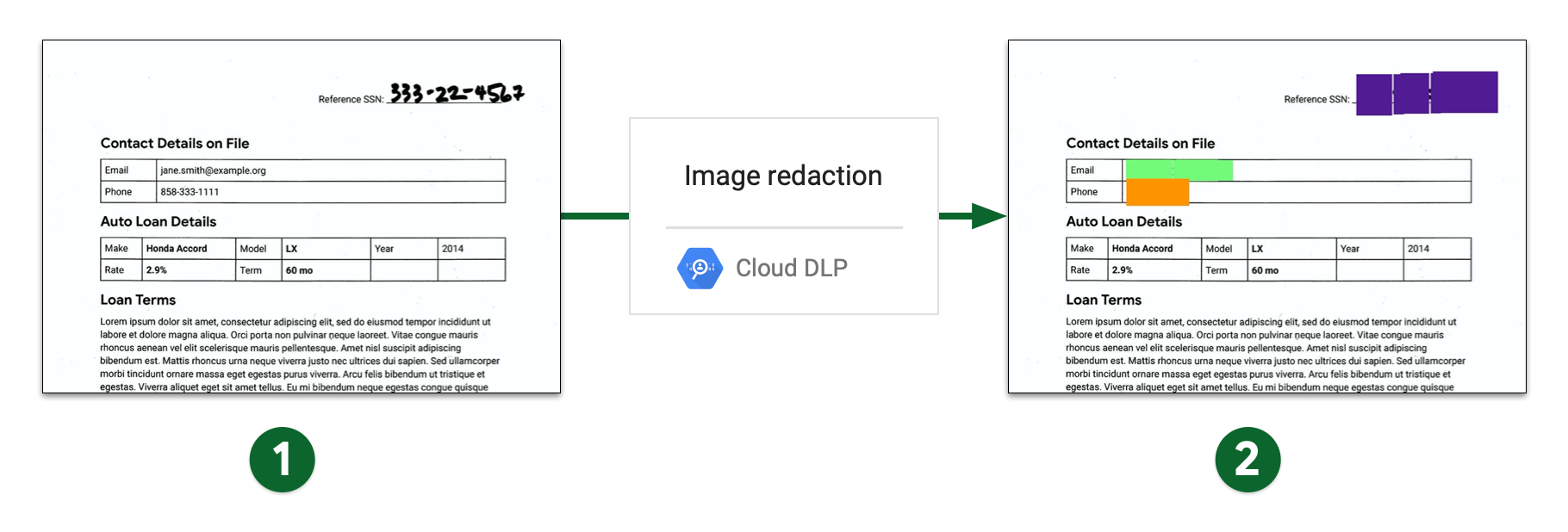
- Immagine scansionata prima dell'oscuramento
- Immagine scansionata dopo l'oscuramento
Limitazioni e considerazioni
Tieni presente i seguenti punti quando oscura i contenuti delle immagini.
Tipi di file supportati
Sensitive Data Protection può oscurare i dati sensibili di molti tipi di immagini, tra cui JPEG, BMP e PNG. Per ulteriori informazioni, consulta Tipi di file supportati.
L'oscuramento dei contenuti non è supportato per i file SVG, PDF, XLSX, PPTX o DOCX.
Trovare i limiti
Quando oscura i dati dalle immagini, i limiti di ricerca non si applicano. Possono causare risultati imprevisti o potenzialmente incoerenti, in cui solo alcuni dati sono oscurati. Se includi FindingLimits nella richiesta, la Protezione dei dati sensibili genera un errore.
Prima di iniziare
- Sign in to your Google Cloud account. If you're new to Google Cloud, create an account to evaluate how our products perform in real-world scenarios. New customers also get $300 in free credits to run, test, and deploy workloads.
-
In the Google Cloud console, on the project selector page, select or create a Google Cloud project.
-
Make sure that billing is enabled for your Google Cloud project.
-
Enable the DLP API.
-
Create a service account:
-
In the Google Cloud console, go to the Create service account page.
Go to Create service account - Select your project.
-
In the Service account name field, enter a name. The Google Cloud console fills in the Service account ID field based on this name.
In the Service account description field, enter a description. For example,
Service account for quickstart. - Click Create and continue.
-
Grant the Project > Owner role to the service account.
To grant the role, find the Select a role list, then select Project > Owner.
- Click Continue.
-
Click Done to finish creating the service account.
Do not close your browser window. You will use it in the next step.
-
-
Create a service account key:
- In the Google Cloud console, click the email address for the service account that you created.
- Click Keys.
- Click Add key, and then click Create new key.
- Click Create. A JSON key file is downloaded to your computer.
- Click Close.
-
Set the environment variable
GOOGLE_APPLICATION_CREDENTIALSto the path of the JSON file that contains your credentials. This variable applies only to your current shell session, so if you open a new session, set the variable again. - Install the Google Cloud CLI.
-
To initialize the gcloud CLI, run the following command:
gcloud init -
In the Google Cloud console, on the project selector page, select or create a Google Cloud project.
-
Make sure that billing is enabled for your Google Cloud project.
-
Enable the DLP API.
-
Create a service account:
-
In the Google Cloud console, go to the Create service account page.
Go to Create service account - Select your project.
-
In the Service account name field, enter a name. The Google Cloud console fills in the Service account ID field based on this name.
In the Service account description field, enter a description. For example,
Service account for quickstart. - Click Create and continue.
-
Grant the Project > Owner role to the service account.
To grant the role, find the Select a role list, then select Project > Owner.
- Click Continue.
-
Click Done to finish creating the service account.
Do not close your browser window. You will use it in the next step.
-
-
Create a service account key:
- In the Google Cloud console, click the email address for the service account that you created.
- Click Keys.
- Click Add key, and then click Create new key.
- Click Create. A JSON key file is downloaded to your computer.
- Click Close.
-
Set the environment variable
GOOGLE_APPLICATION_CREDENTIALSto the path of the JSON file that contains your credentials. This variable applies only to your current shell session, so if you open a new session, set the variable again. - Install the Google Cloud CLI.
-
To initialize the gcloud CLI, run the following command:
gcloud init
Oscurare tutti gli infoType predefiniti in un'immagine
Per oscurare i dati sensibili in un'immagine, inviala al metodo
image.redact dell'API DLP.
A meno che non specifichi tipi di informazioni specifici (infoTypes) da cercare, Sensitive Data Protection cerca gli infoType più comuni.
Per oscurare gli infoType predefiniti in un'immagine:
Codifica l'immagine come stringa base64.
Se prevedi di utilizzare una delle librerie client Sensitive Data Protection per eseguire questa attività, salta questo passaggio.
Invia una richiesta al metodo
image.redact.Se vuoi oscurare gli infoType predefiniti, la richiesta richiede solo l'immagine con codifica base64.
Ad esempio, considera l'immagine seguente. Questo è un esempio di file immagine tipico generato dalla scansione di un documento cartaceo.
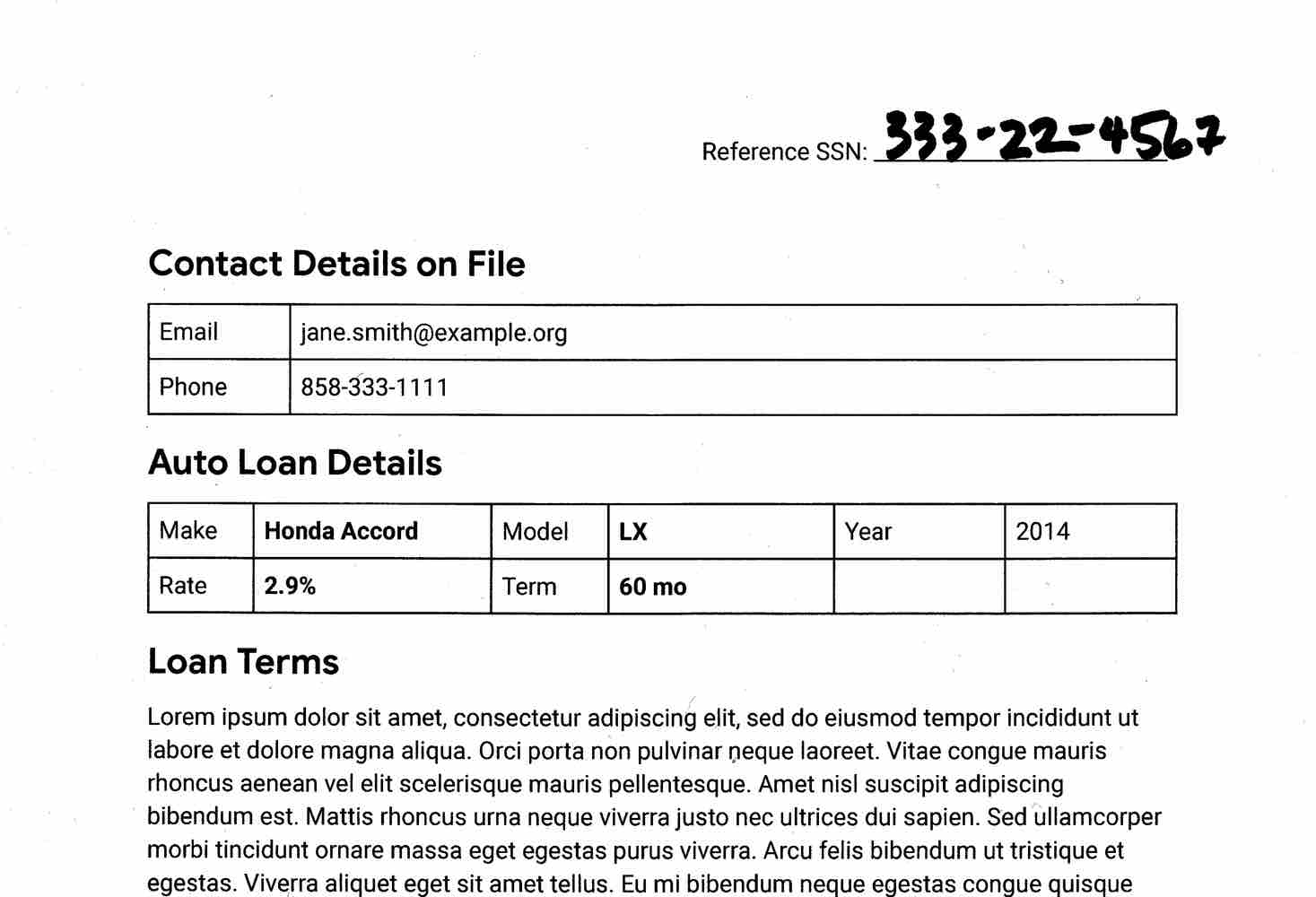
Per oscurare gli infoType predefiniti da questa immagine, invia la seguente richiesta al metodo image.redact dell'API DLP:
C#
Per scoprire come installare e utilizzare la libreria client per Sensitive Data Protection, consulta Librerie client di Sensitive Data Protection.
Per autenticarti a Sensitive Data Protection, configura le Credenziali predefinite dell'applicazione. Per ulteriori informazioni, consulta Configurare l'autenticazione per un ambiente di sviluppo locale.
Go
Per scoprire come installare e utilizzare la libreria client per Sensitive Data Protection, consulta Librerie client di Sensitive Data Protection.
Per autenticarti a Sensitive Data Protection, configura le Credenziali predefinite dell'applicazione. Per ulteriori informazioni, consulta Configurare l'autenticazione per un ambiente di sviluppo locale.
Java
Per scoprire come installare e utilizzare la libreria client per Sensitive Data Protection, consulta Librerie client di Sensitive Data Protection.
Per autenticarti a Sensitive Data Protection, configura le Credenziali predefinite dell'applicazione. Per ulteriori informazioni, consulta Configurare l'autenticazione per un ambiente di sviluppo locale.
Node.js
Per scoprire come installare e utilizzare la libreria client per Sensitive Data Protection, consulta Librerie client di Sensitive Data Protection.
Per autenticarti a Sensitive Data Protection, configura le Credenziali predefinite dell'applicazione. Per ulteriori informazioni, consulta Configurare l'autenticazione per un ambiente di sviluppo locale.
PHP
Per scoprire come installare e utilizzare la libreria client per Sensitive Data Protection, consulta Librerie client di Sensitive Data Protection.
Per autenticarti a Sensitive Data Protection, configura le Credenziali predefinite dell'applicazione. Per ulteriori informazioni, consulta Configurare l'autenticazione per un ambiente di sviluppo locale.
Python
Per scoprire come installare e utilizzare la libreria client per Sensitive Data Protection, consulta Librerie client di Sensitive Data Protection.
Per autenticarti a Sensitive Data Protection, configura le Credenziali predefinite dell'applicazione. Per ulteriori informazioni, consulta Configurare l'autenticazione per un ambiente di sviluppo locale.
REST
{ "byteItem": { "data": "[BASE64-ENCODED-IMAGE]", "type": "IMAGE_JPEG" } }
Sensitive Data Protection restituisce quanto segue:
{ "redactedImage": "[BASE64-ENCODED-IMAGE]" }
Decodifica l'immagine codificata in base64.
L'immagine risultante sarà la seguente:
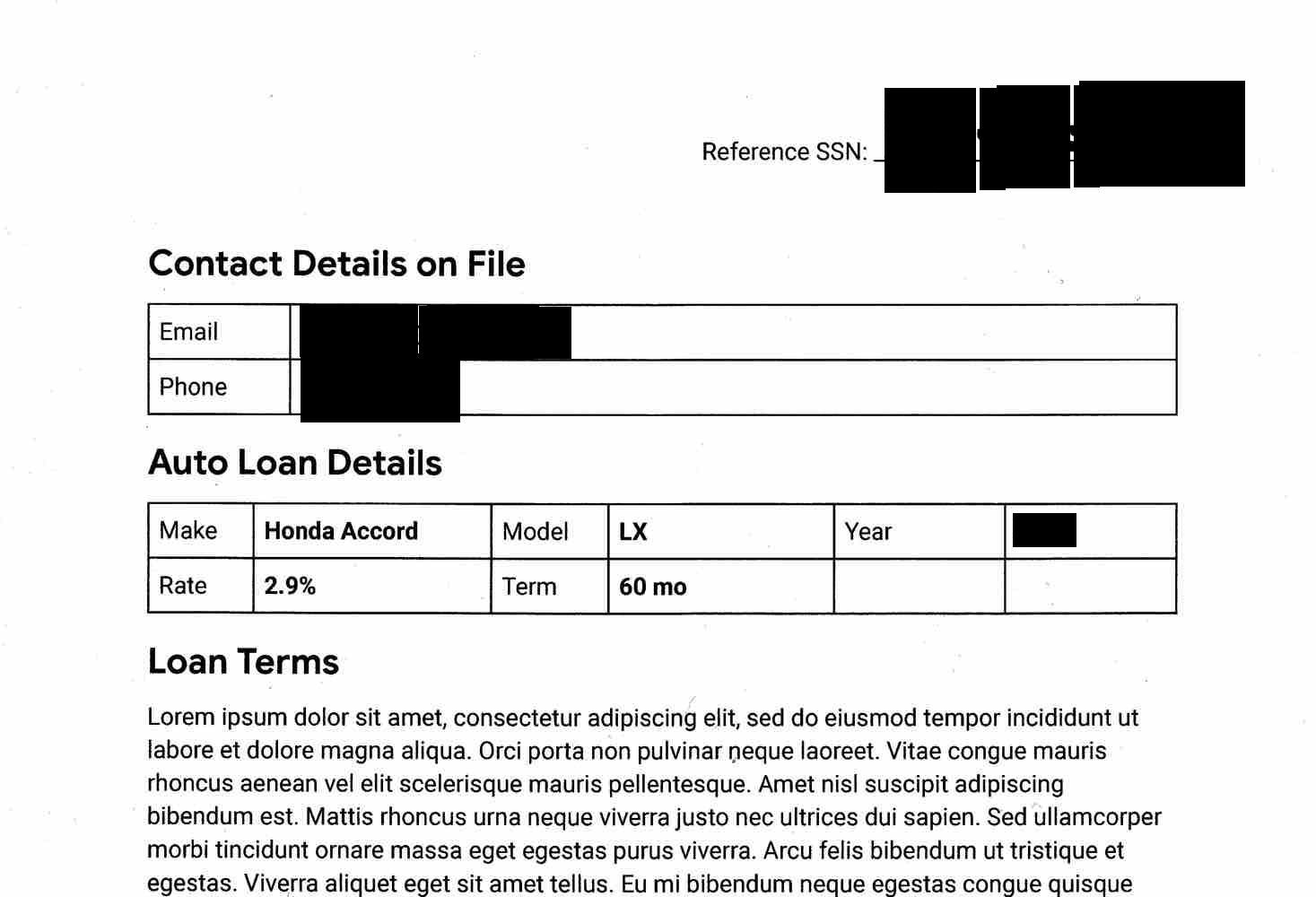
Tieni presente che, oltre a mascherare il numero di previdenza sociale scritto a mano, l'indirizzo email e il numero di telefono, la Protezione dei dati sensibili ha oscurato anche l'anno. La sezione successiva dimostra come oscurare solo determinati infoType.
Oscurare infoType specifici in un'immagine
Se vuoi oscurare solo alcuni dati sensibili in un'immagine, specifica gli infoType integrati corrispondenti.
Per oscurare infoType specifici da un'immagine, invia una richiesta al metodo image.redact dell'API DLP. La richiesta deve includere quanto segue:
- L'immagine.
- Uno o più rilevatori di infoType.
Considera l'immagine originale della sezione precedente. Per oscurare solo
codici fiscali, indirizzi email e numeri di telefono degli Stati Uniti, invia il
seguente JSON al metodo
image.redact dell'API DLP:
C#
Per scoprire come installare e utilizzare la libreria client per Sensitive Data Protection, consulta Librerie client di Sensitive Data Protection.
Per autenticarti a Sensitive Data Protection, configura le Credenziali predefinite dell'applicazione. Per ulteriori informazioni, consulta Configurare l'autenticazione per un ambiente di sviluppo locale.
Go
Per scoprire come installare e utilizzare la libreria client per Sensitive Data Protection, consulta Librerie client di Sensitive Data Protection.
Per autenticarti a Sensitive Data Protection, configura le Credenziali predefinite dell'applicazione. Per ulteriori informazioni, consulta Configurare l'autenticazione per un ambiente di sviluppo locale.
Java
Per scoprire come installare e utilizzare la libreria client per Sensitive Data Protection, consulta Librerie client di Sensitive Data Protection.
Per autenticarti a Sensitive Data Protection, configura le Credenziali predefinite dell'applicazione. Per ulteriori informazioni, consulta Configurare l'autenticazione per un ambiente di sviluppo locale.
Node.js
Per scoprire come installare e utilizzare la libreria client per Sensitive Data Protection, consulta Librerie client di Sensitive Data Protection.
Per autenticarti a Sensitive Data Protection, configura le Credenziali predefinite dell'applicazione. Per ulteriori informazioni, consulta Configurare l'autenticazione per un ambiente di sviluppo locale.
PHP
Per scoprire come installare e utilizzare la libreria client per Sensitive Data Protection, consulta Librerie client di Sensitive Data Protection.
Per autenticarti a Sensitive Data Protection, configura le Credenziali predefinite dell'applicazione. Per ulteriori informazioni, consulta Configurare l'autenticazione per un ambiente di sviluppo locale.
Python
Per scoprire come installare e utilizzare la libreria client per Sensitive Data Protection, consulta Librerie client di Sensitive Data Protection.
Per autenticarti a Sensitive Data Protection, configura le Credenziali predefinite dell'applicazione. Per ulteriori informazioni, consulta Configurare l'autenticazione per un ambiente di sviluppo locale.
REST
{ "byteItem": { "data": "[BASE64-ENCODED-IMAGE]", "type": "IMAGE_JPEG" }, "imageRedactionConfigs": [ { "infoType": { "name": "US_SOCIAL_SECURITY_NUMBER" } }, { "infoType": { "name": "EMAIL_ADDRESS" } }, { "infoType": { "name": "PHONE_NUMBER" } } ] }
Sensitive Data Protection restituisce quanto segue:
{ "redactedImage": "[BASE64-ENCODED-IMAGE]" }
Decodifica l'immagine codificata in base64.
L'immagine risultante sarà la seguente:
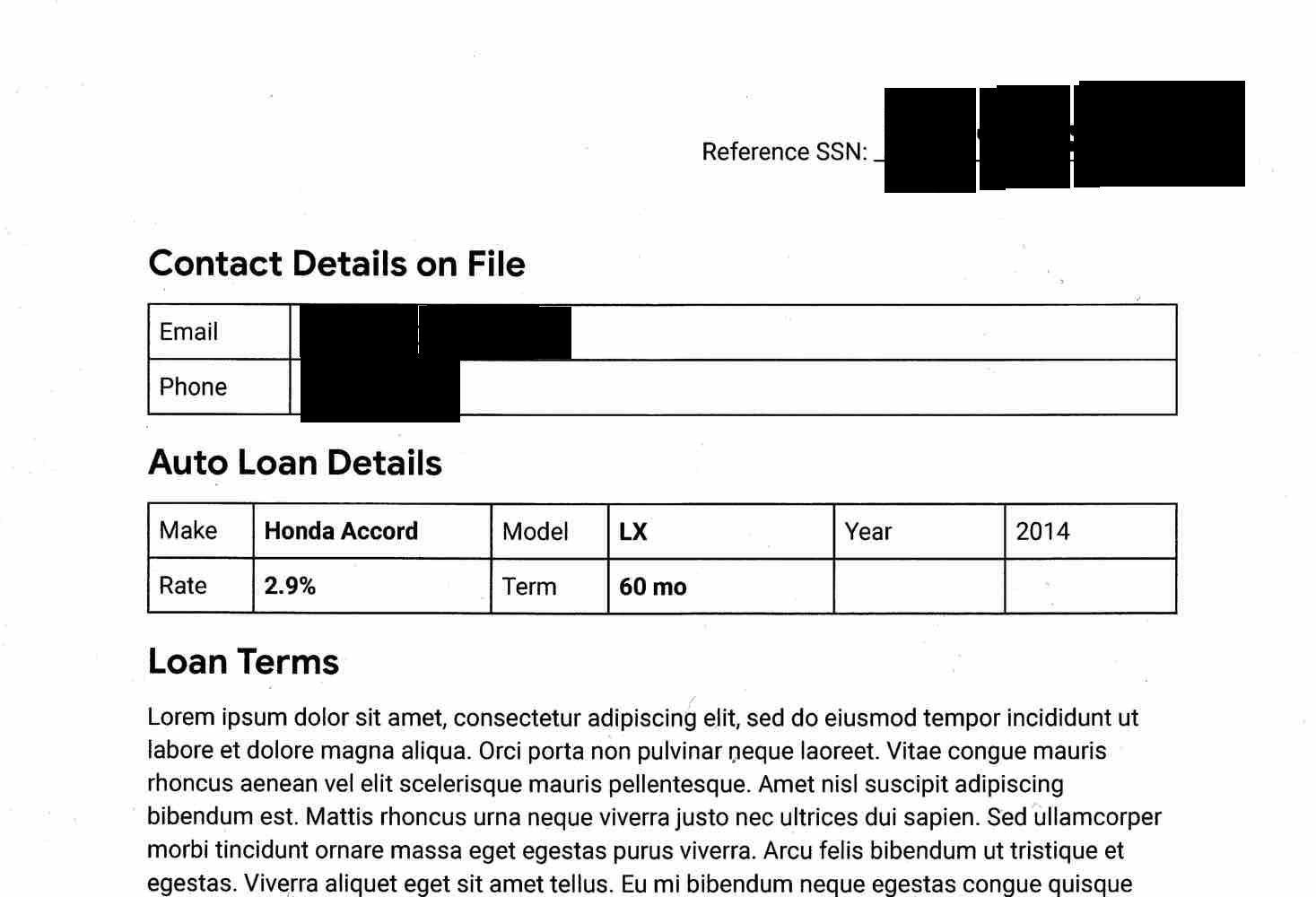
Puoi codificare in base al colore le informazioni oscurate in base all'infoType quando vuoi capire subito cosa è stato oscurato. Per ulteriori informazioni, consulta la sezione seguente.
Oscurare gli infoType in un'immagine con codifica a colori
Per applicare un codice colore alle informazioni oscurate in base all'infoType, accoppia i rilevatori di infoType con i valori dello spazio colore RGB.
Per assegnare un codice colore agli infoType oscurati da un'immagine, invia una richiesta al metodo image.redact dell'API DLP. La richiesta deve includere quanto segue:
- L'immagine.
- Uno o più rilevatori di infoType, a ciascuno dei quali viene assegnato un colore utilizzando i valori dello spazio colore RGB.
Considera l'immagine originale della prima sezione. Per oscurare
i numeri di previdenza sociale degli Stati Uniti con una casella viola, gli indirizzi email con una casella verde
e i numeri di telefono con una casella arancione, invia il seguente JSON al metodo
image.redact dell'API DLP:
C#
Per scoprire come installare e utilizzare la libreria client per Sensitive Data Protection, consulta Librerie client di Sensitive Data Protection.
Per autenticarti a Sensitive Data Protection, configura le Credenziali predefinite dell'applicazione. Per ulteriori informazioni, consulta Configurare l'autenticazione per un ambiente di sviluppo locale.
Go
Per scoprire come installare e utilizzare la libreria client per Sensitive Data Protection, consulta Librerie client di Sensitive Data Protection.
Per autenticarti a Sensitive Data Protection, configura le Credenziali predefinite dell'applicazione. Per ulteriori informazioni, consulta Configurare l'autenticazione per un ambiente di sviluppo locale.
Java
Per scoprire come installare e utilizzare la libreria client per Sensitive Data Protection, consulta Librerie client di Sensitive Data Protection.
Per autenticarti a Sensitive Data Protection, configura le Credenziali predefinite dell'applicazione. Per ulteriori informazioni, consulta Configurare l'autenticazione per un ambiente di sviluppo locale.
Node.js
Per scoprire come installare e utilizzare la libreria client per Sensitive Data Protection, consulta Librerie client di Sensitive Data Protection.
Per autenticarti a Sensitive Data Protection, configura le Credenziali predefinite dell'applicazione. Per ulteriori informazioni, consulta Configurare l'autenticazione per un ambiente di sviluppo locale.
PHP
Per scoprire come installare e utilizzare la libreria client per Sensitive Data Protection, consulta Librerie client di Sensitive Data Protection.
Per autenticarti a Sensitive Data Protection, configura le Credenziali predefinite dell'applicazione. Per ulteriori informazioni, consulta Configurare l'autenticazione per un ambiente di sviluppo locale.
Python
Per scoprire come installare e utilizzare la libreria client per Sensitive Data Protection, consulta Librerie client di Sensitive Data Protection.
Per autenticarti a Sensitive Data Protection, configura le Credenziali predefinite dell'applicazione. Per ulteriori informazioni, consulta Configurare l'autenticazione per un ambiente di sviluppo locale.
REST
{ "byteItem": { "data": "[BASE64-ENCODED-IMAGE]", "type": "IMAGE_JPEG" }, "imageRedactionConfigs": [ { "infoType": { "name": "US_SOCIAL_SECURITY_NUMBER" }, "redactionColor": { "red": 0.3, "green": 0.1, "blue": 0.6 } }, { "infoType": { "name": "EMAIL_ADDRESS" }, "redactionColor": { "red": 0.5, "blue": 0.5, "green": 1 } }, { "infoType": { "name": "PHONE_NUMBER" }, "redactionColor": { "red": 1, "blue": 0, "green": 0.6 } } ] }
Sensitive Data Protection restituisce quanto segue:
{ "redactedImage": "[BASE64-ENCODED-IMAGE]" }
Decodifica l'immagine codificata in base64.
L'immagine risultante sarà la seguente:
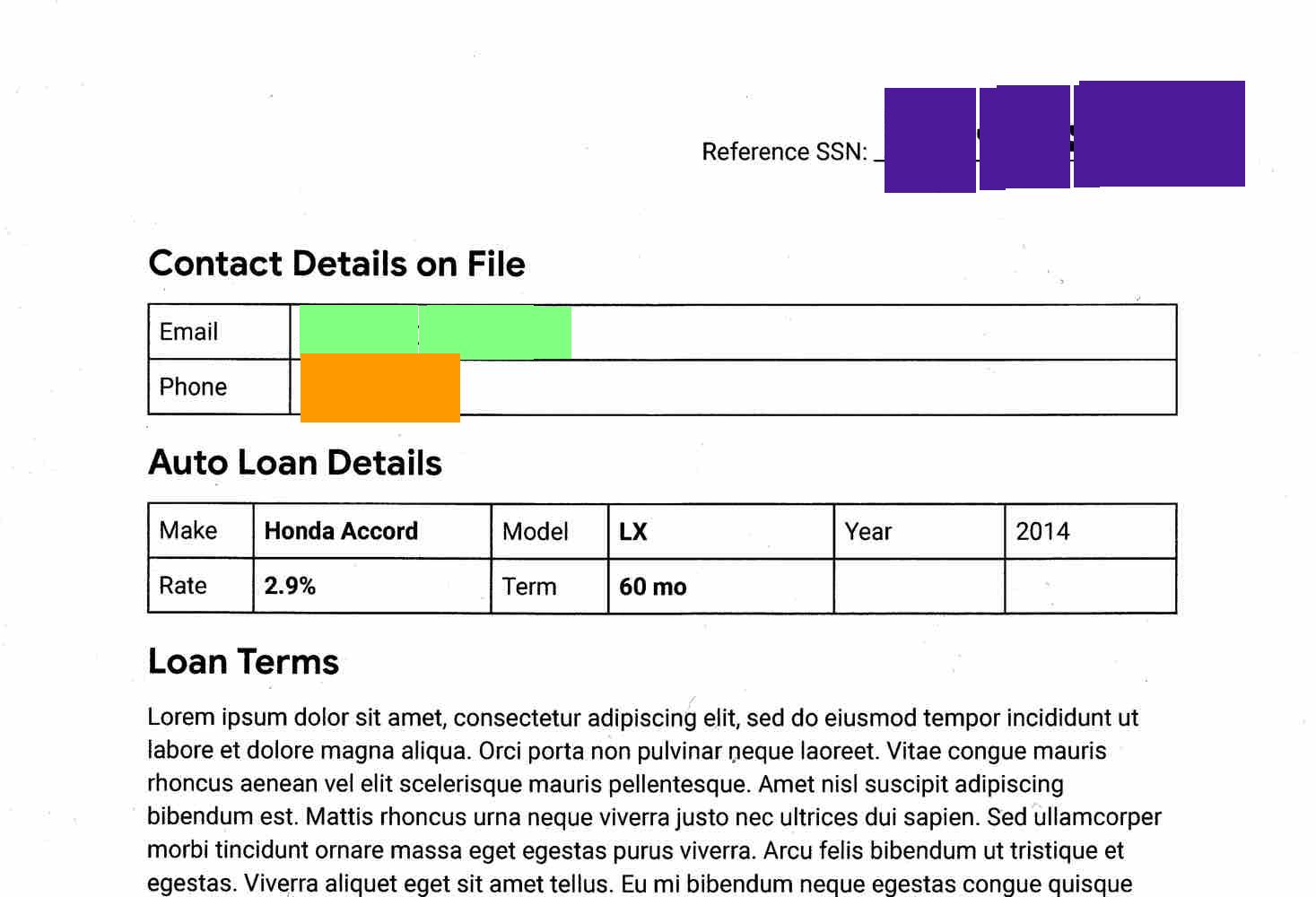
Oscurare tutto il testo di un'immagine
Sensitive Data Protection contiene anche un'opzione per oscurare tutto il testo rilevato in un'immagine.
Per oscurare tutto il testo di un'immagine, invia una richiesta al metodo
image.redact dell'API DLP. La richiesta deve includere quanto segue:
- L'immagine.
- L'opzione
redactAllTextimpostata sutrue.
Considera l'immagine originale della prima sezione. Per oscurare tutto il testo, invia il seguente JSON al metodo image.redact dell'API DLP:
C#
Per scoprire come installare e utilizzare la libreria client per Sensitive Data Protection, consulta Librerie client di Sensitive Data Protection.
Per autenticarti a Sensitive Data Protection, configura le Credenziali predefinite dell'applicazione. Per ulteriori informazioni, consulta Configurare l'autenticazione per un ambiente di sviluppo locale.
Go
Per scoprire come installare e utilizzare la libreria client per Sensitive Data Protection, consulta Librerie client di Sensitive Data Protection.
Per autenticarti a Sensitive Data Protection, configura le Credenziali predefinite dell'applicazione. Per ulteriori informazioni, consulta Configurare l'autenticazione per un ambiente di sviluppo locale.
Java
Per scoprire come installare e utilizzare la libreria client per Sensitive Data Protection, consulta Librerie client di Sensitive Data Protection.
Per autenticarti a Sensitive Data Protection, configura le Credenziali predefinite dell'applicazione. Per ulteriori informazioni, consulta Configurare l'autenticazione per un ambiente di sviluppo locale.
Node.js
Per scoprire come installare e utilizzare la libreria client per Sensitive Data Protection, consulta Librerie client di Sensitive Data Protection.
Per autenticarti a Sensitive Data Protection, configura le Credenziali predefinite dell'applicazione. Per ulteriori informazioni, consulta Configurare l'autenticazione per un ambiente di sviluppo locale.
PHP
Per scoprire come installare e utilizzare la libreria client per Sensitive Data Protection, consulta Librerie client di Sensitive Data Protection.
Per autenticarti a Sensitive Data Protection, configura le Credenziali predefinite dell'applicazione. Per ulteriori informazioni, consulta Configurare l'autenticazione per un ambiente di sviluppo locale.
Python
Per scoprire come installare e utilizzare la libreria client per Sensitive Data Protection, consulta Librerie client di Sensitive Data Protection.
Per autenticarti a Sensitive Data Protection, configura le Credenziali predefinite dell'applicazione. Per ulteriori informazioni, consulta Configurare l'autenticazione per un ambiente di sviluppo locale.
REST
{ "byteItem": { "data": "[BASE64-ENCODED-IMAGE]", "type": "IMAGE_JPEG" }, "imageRedactionConfigs": [ { "redactAllText": true } ] }
Sensitive Data Protection restituisce quanto segue:
{ "redactedImage": "[BASE64-ENCODED-IMAGE]" }
Decodifica l'immagine codificata in base64.
L'API restituisce le stesse immagini che hai fornito, ma qualsiasi testo identificato come contenente informazioni sensibili in base ai tuoi criteri è stato oscurato.
L'immagine risultante sarà la seguente:
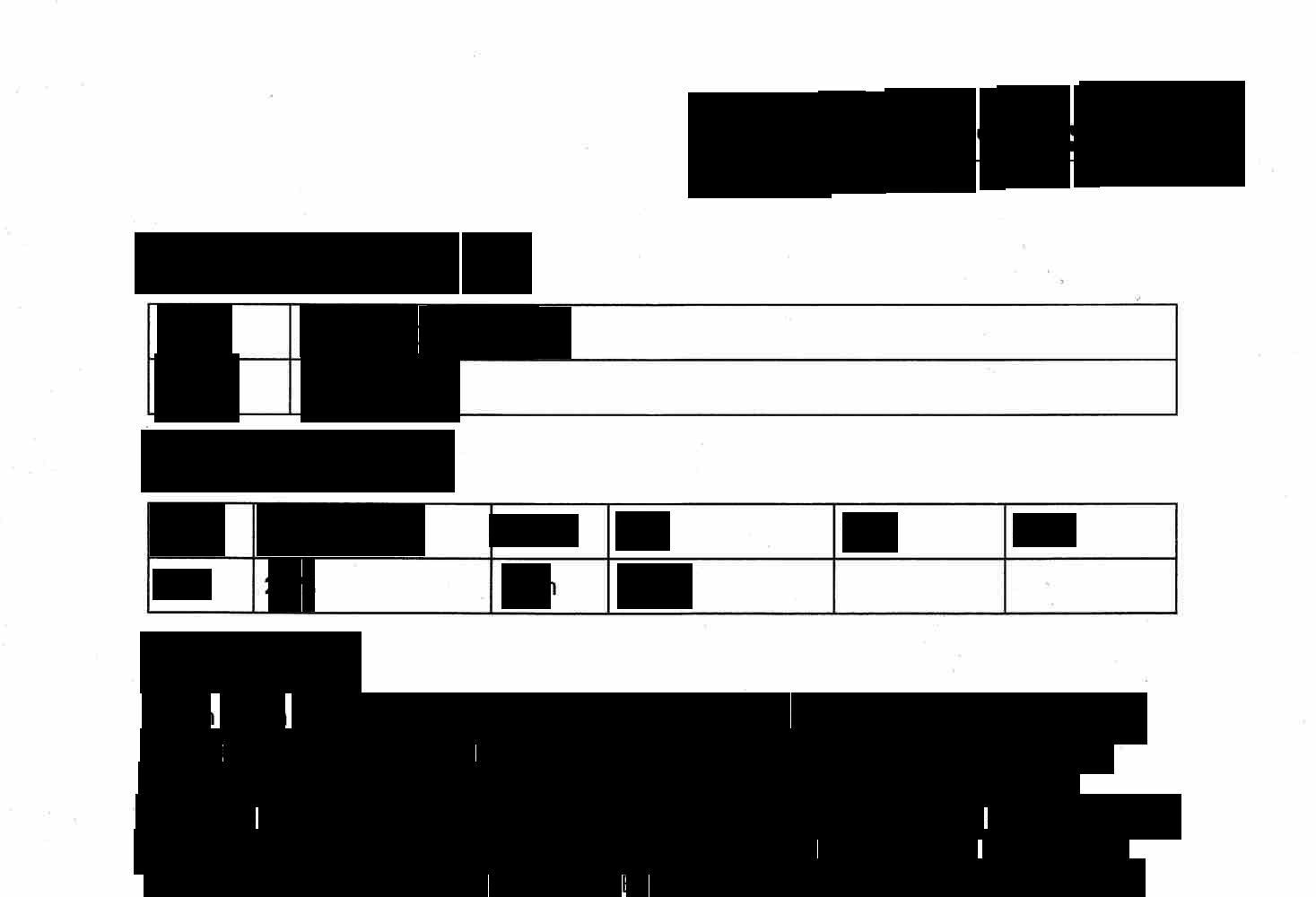
Esempio di codice con impostazione della probabilità
Questo esempio è simile a Oscurare infoType specifici da un'immagine. Inoltre, mostra come specificare una probabilità minima.
C#
Per scoprire come installare e utilizzare la libreria client per Sensitive Data Protection, consulta Librerie client di Sensitive Data Protection.
Per autenticarti a Sensitive Data Protection, configura le Credenziali predefinite dell'applicazione. Per ulteriori informazioni, consulta Configurare l'autenticazione per un ambiente di sviluppo locale.
Go
Per scoprire come installare e utilizzare la libreria client per Sensitive Data Protection, consulta Librerie client di Sensitive Data Protection.
Per autenticarti a Sensitive Data Protection, configura le Credenziali predefinite dell'applicazione. Per ulteriori informazioni, consulta Configurare l'autenticazione per un ambiente di sviluppo locale.
Java
Per scoprire come installare e utilizzare la libreria client per Sensitive Data Protection, consulta Librerie client di Sensitive Data Protection.
Per autenticarti a Sensitive Data Protection, configura le Credenziali predefinite dell'applicazione. Per ulteriori informazioni, consulta Configurare l'autenticazione per un ambiente di sviluppo locale.
Node.js
Per scoprire come installare e utilizzare la libreria client per Sensitive Data Protection, consulta Librerie client di Sensitive Data Protection.
Per autenticarti a Sensitive Data Protection, configura le Credenziali predefinite dell'applicazione. Per ulteriori informazioni, consulta Configurare l'autenticazione per un ambiente di sviluppo locale.
PHP
Per scoprire come installare e utilizzare la libreria client per Sensitive Data Protection, consulta Librerie client di Sensitive Data Protection.
Per autenticarti a Sensitive Data Protection, configura le Credenziali predefinite dell'applicazione. Per ulteriori informazioni, consulta Configurare l'autenticazione per un ambiente di sviluppo locale.
Python
Per scoprire come installare e utilizzare la libreria client per Sensitive Data Protection, consulta Librerie client di Sensitive Data Protection.
Per autenticarti a Sensitive Data Protection, configura le Credenziali predefinite dell'applicazione. Per ulteriori informazioni, consulta Configurare l'autenticazione per un ambiente di sviluppo locale.
Fai una prova
Puoi provare personalmente ciascuno degli esempi in questa pagina o eseguire esperimenti con le tue immagini in Explorer API nella pagina di riferimento perimage.redact:
Passaggi successivi
- Scopri di più su ispezione e oscuramento delle immagini.
- Completa il codelab Oscurare i dati sensibili con Sensitive Data Protection.
- Scopri come ispezionare le immagini per rilevare dati sensibili.
- Scopri di più sulla creazione di una copia anonimizzata dei dati nello stoccaggio.

